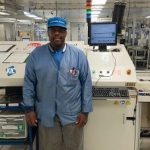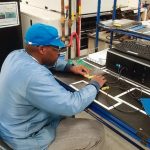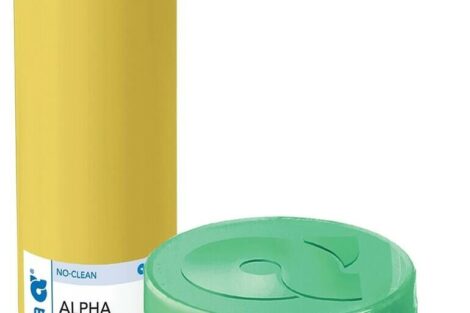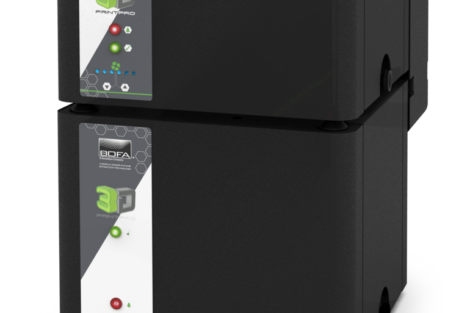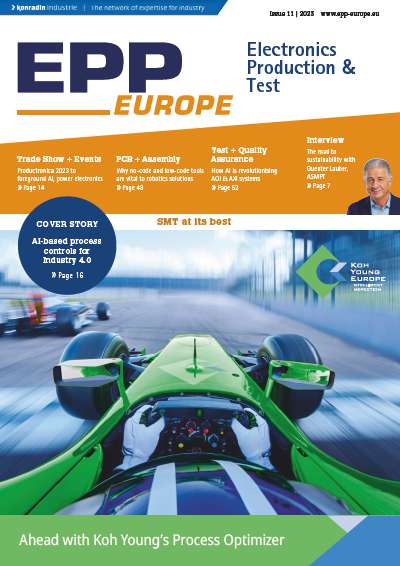Process Engineer, Rod Sampson, is responsible for the thermal processes, which include reflow, wave, and selective wave soldering. For each new product introduction (NPI), Design of Experiment (DoE) is run to identify the “sweet spot” in the thermal process. This typically entails experimenting with machine settings that result in a process (profile) in the high, low, and center points of the process window. (The company’s HQ provides the appropriate process window.) When the best process is identified, it is locked in place, then tracked and verified daily. While defects are rarely attributed to the reflow process, the challenges that are encountered when defects that actually do occur are often more difficult to resolve. Quality is not something that should be weighted between the different processes, as weights are of little importance once an assembly has been rendered defective. In this case, all involved should go about their business as if their respective processes are the most crucial/vital from a quality standpoint. With this, the impact of internal and external defects can be minimized, positively driving overall factory productivity.
The recent trend to aggressively reduce solder void has made process optimization and consistent soldering critical for success. Previously this work was time consuming, and although the quality was acceptable, productivity and cost effectiveness suffered due to the necessary line stoppage to perform the work. It was challenging due to the numerous generations of reflow ovens and wave solder machines. Not only do their thermal properties differ, but the older machines made performance tracking difficult. In today’s age with virtually unlimited information available via a click, the company’s method was outdated and inadequate. There had to be a better way.
“We researched the market and found new technologies that seemed promising. One was a smart thermal profiler with predictive process optimization software that allowed us to input the process window target, and immediately identify the corresponding machine settings. This cut our process optimization time dramatically, and it allowed us to find more optimum process settings than in the past,” explained Rod Sampson.
“Previously, we had relied on technicians performing manual process verifications on each line multiple times per day. This was less than optimum because such manual verification is not consistent, and it also reduced our productivity by stopping the entire line for 10 + minutes every time a verification profile was run on a reflow oven,” he further explained. Additional verification events were prompted by yield issues, preventive maintenance work, and unscheduled line stoppage. (Their procedures required running a profile if the line stoppage exceeds four hours.) A secondary concern was the lack of information on the thermal process during the production between the twice daily manual profiles.
It was decided to invest in KIC’s automatic profiling systems for reflow that use permanently embedded sensors in the oven to calculate each PCB’s profile on the fly during production. The automatic profiling systems were retrofittable on all reflow ovens regardless of age, giving consistent process tracking and traceability across all lines. To test the non-contact profile accuracy and repeatability, changes were forced in the oven while verifying that the system did indeed correctly identify the resulting out-of-spec event. “I also found it interesting that we could stop a blower motor in the reflow oven without triggering an oven alarm or notification,” explained Mr. Sampson. “This probably is due to the temperature not changing. But the convection rate had changed, causing the profile on the PCBs to change, which is what determines the in-spec production.”
The automatic system allows for the reflow process to be controlled and documented. In addition to full thermal process traceability, the system instantly gives a notification for an out-of-spec event. It will also provide SPC charting with Cpk limits that provide early warning on an out-of-control reflow process. Hence, the company replaced manual verification profile spot checks with on-the-fly profiling of every PCB.
However, it was challenging to make use of the thermal process data for trend analysis, yield troubleshooting, and other issues due to the sheer volume of data located on each reflow oven PC. “One of our use cases would be triggered by a negative trend in our production line yield. In the past, it could take me more than a day (accounting for the normal interruptions in a workplace) to put together a trend analysis report to gain the appropriate insight to take corrective action on yield issues. When we stop the production line, we are keenly aware that every second of downtime is expensive. SPI and AOI inspection are very helpful. And while sometimes the root cause of the problem is obvious, other times, it isn’t. Fortunately, Vantage, a new factory-level database software, became available that made accessing the relevant data quick and convenient. Now I can identify the thermal process for a specific PCB or time period with a deteriorating production line yield. We will quickly rule the thermal process in or out, reducing troubleshooting time. And should reflow be the problem, which happens quite infrequently, then the automatic profiling system points us to where and what in the oven needs to be adjusted,” he further added.
“This progression made me realize that I had previously lacked timely reflow process data to make good decisions, and suddenly I had so much information that I was still not able to take corrective action quickly enough,” Mr. Sampson observed. The introduction of the Vantage factory-level database software changed that by moving from data to insight. It is similar to looking for information online. Collecting massive volumes of data can be easily captured, but a strong browser or analytical tool is needed to identify the relevant information or answers needed. Data is turned into insight, and insight is always quickly needed.
A final dramatic use case, which improved the production line uptime by several hours for each event, was the occasional inability to run the profile verification due to broken thermocouples (TCs), damaged profile board or other. If such occurrences took place when the responsible process engineer was unavailable, for example on a night shift, then the line was shut down until a profile verification could be performed. Shutting the line down for several hours because of a broken profiler or a TC, may sound unheard of, but the top priority is quality. The company, however, is now no longer held hostage by such events.
Every year, the company conducts an internal competition on improvements in two main categories:
- Quality: improvements & assurance
- Cost reduction: cost & time savings
The regional Calsonic contest was won with the following results:
- Defects due to out-of-spec profiles all but disappeared
- Automatic verification of process adherence
- Effective void reduction
- Near elimination of periodic profiling downtime led to an increase of production time
- Improved set-up time for new products (NPI)
- Line utilization gains of multiple minutes for each of the following events:
a. Preventive maintenance
b. Troubleshooting yield issues
c. Unscheduled stoppage
- Full thermal process traceability for every produced PCB –
customer satisfaction - Dramatic decrease of production stoppage due to inability
to run manual profiles
The future
As a company, they have high aspirations of using technology to drive the core initiatives of quality and cost effectiveness. “Personally, I envision a factory with smart machines and processes, with real-time dashboards connected to an MES system. Where manual and inconsistent tasks can be replaced with automation for better process control as well as improved quality and production. Eventually, we will be able to use data, insight and automation to run our factory more effectively. Perhaps there is another competition, we can win soon,” added Mr. Sampson.
SMTconnect, Booth 4A-230
www.kicthermal.com; www.calsonickansei.co.jp/en
Zusammenfassung
Ein multinationaler Automobilzulieferer mit Fokus auf Qualität und Effizienz beschloss, seinen Reflowprozess zu optimieren, und entschied sich dabei für ein automatisches Profilierungssystem, welches nachrüstbar war und eine lückenlose Prozessverfolgung sowie Rückverfolgbarkeit über alle Linien hinweg ermöglicht.
Résumé
Un fournisseur international dans l’industrie automobile, centré sur la qualité et l’efficacité, a décidé d’optimiser son processus de refusion, en optant pour un système de profilage automatique afin d‘assurer un suivi et une traçabilité transparents des processus sur toutes les lignes de production.
Резюме
Международный автоконцерн, уделяющий особое внимание качеству и эффективности, пожелал оптимизировать процесс пайки оплавлением, для чего принял решение о приобретении дооснащаемой автоматической системы профилирования, позволяющей внимательно отслеживать все этапы процессов, а также собирать весь объем информации об изделии на всех линиях.


